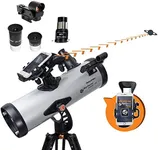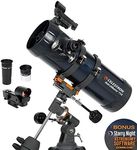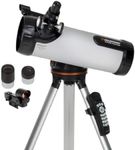Buying Guide for the Best Celestron Telescopes
Choosing the right telescope can be an exciting yet daunting task, especially with the variety of options available. To make an informed decision, it's important to understand the key specifications that differentiate one telescope from another. These specifications will help you determine which telescope best fits your needs, whether you're a beginner stargazer or an experienced astronomer. Let's dive into the key specs and what they mean for your telescope experience.ApertureThe aperture is the diameter of the telescope's main optical component, which can be a lens or a mirror. This spec is crucial because it determines how much light the telescope can gather. A larger aperture allows you to see fainter objects and more detail. Apertures can range from small (around 70mm) to large (over 200mm). For beginners, an aperture of 70-100mm is usually sufficient for viewing the moon and planets. Intermediate users might prefer 100-150mm to see more detail and some deep-sky objects. Advanced users often go for 150mm and above to explore deep-sky objects in greater detail.
Focal LengthThe focal length is the distance between the telescope's main optical component and the point where the image is brought into focus. This spec affects the magnification and field of view. A longer focal length provides higher magnification but a narrower field of view, which is great for observing planets. Shorter focal lengths offer a wider field of view, making them better for viewing larger areas of the sky, such as star clusters. Beginners might start with a moderate focal length (around 700-1000mm) for versatility, while more experienced users can choose based on their specific interests.
MagnificationMagnification is how much larger an object appears through the telescope compared to the naked eye. It's determined by dividing the focal length of the telescope by the focal length of the eyepiece. While high magnification can be tempting, it's not always better. Too much magnification can make images blurry and hard to track. For general use, a range of 50x to 150x is usually sufficient. Beginners should focus on lower magnifications to get clear, stable images, while more experienced users can experiment with higher magnifications for detailed observations.
Mount TypeThe mount is what holds the telescope and allows you to point it at different parts of the sky. There are two main types: altazimuth and equatorial. Altazimuth mounts move up-down and left-right, making them simpler and more intuitive for beginners. Equatorial mounts are aligned with the Earth's axis and are better for tracking celestial objects as they move across the sky, which is useful for astrophotography. Beginners might prefer an altazimuth mount for ease of use, while intermediate and advanced users might opt for an equatorial mount for more precise tracking.
Optical DesignTelescopes come in different optical designs, including refractors, reflectors, and compound (catadioptric) telescopes. Refractors use lenses and are known for their sharp images and low maintenance. Reflectors use mirrors and offer larger apertures at a lower cost but require regular alignment. Compound telescopes combine lenses and mirrors, offering compact designs and versatility. Beginners might start with a refractor for its ease of use, while intermediate users might prefer a reflector for its larger aperture. Advanced users often choose compound telescopes for their versatility and portability.
PortabilityPortability refers to how easy it is to transport and set up the telescope. This is important if you plan to take your telescope to different locations. Smaller, lighter telescopes are easier to carry and set up, making them ideal for beginners and those who travel frequently. Larger telescopes offer better viewing capabilities but can be cumbersome to move. Consider your observing habits and choose a telescope that balances performance with portability. If you plan to observe from your backyard, a larger, less portable telescope might be fine. If you need to travel to dark-sky sites, a more portable option is better.
















